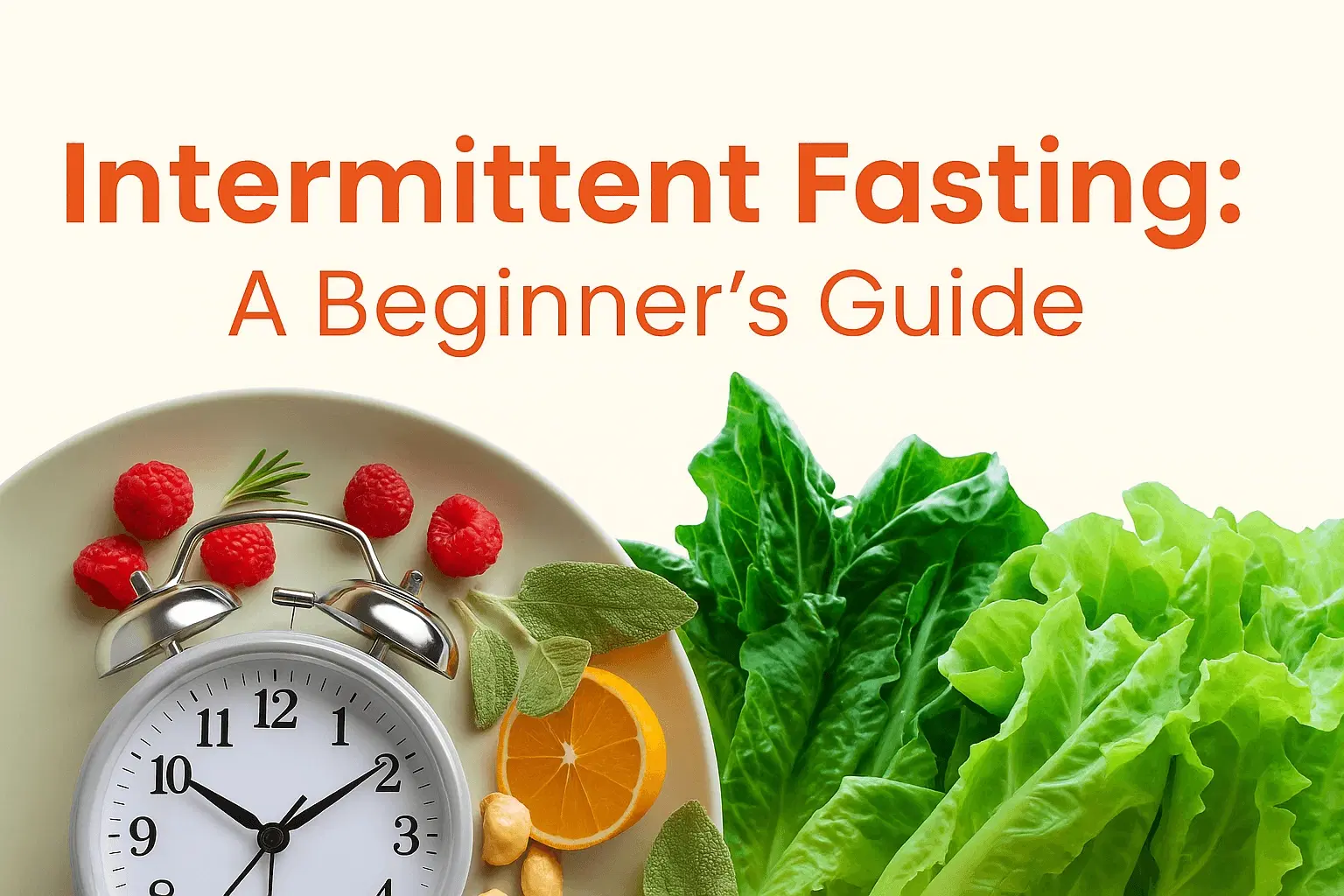Intermittent Fasting Diet Plan

Most diets tell you ‘what’ to eat, intermittent fasting changes the game by focusing on ‘when’. It's actually a simple pattern that gives your body enough time to reset, burn fat more quite efficiently, and stay energised through the day.
It sets apart from regular strict diets or calorie counting, because intermittent fasting (or IF) is more of a pattern than a plan, alternating between eating and fasting windows that help revise your system and simplify your routine.
In this guide, we’ll break down what IF is, how it works, the most common fasting styles, and how to start in a way that fits your lifestyle, backed by science (not hype).
Intermittent Fasting Explained
As suggested above, Intermittent fasting (IF) is precisely about timing, cycling between eating and fasting periods so your body gets enough time to recharge and use the stored energy more efficiently.
When you keep fast, your body makes a rapid shift, it moves from burning glucose for quick energy to using stored fat instead. This process is called the metabolic switch. As the National Library of Medicine stated that this metabolic switch usually happens between 12 to 36 hours after your last meal.
How Intermittent Fasting helps you feel, focus, and live better
Weight Loss and Fat Burning
According to a Healthline article, intermittent fasting naturally creates a calorie deficit by reducing how often you eat, fewer eating hours, not lesser quantity of food. During this time, hormonal shifts make fat-burning more effective. Human growth hormone levels rise, while norepinephrine, a key fat-burning hormone, signals fat cells to release energy more efficiently.
Improved Metabolic Health
Intermittent fasting helps regulate your blood sugar and insulin. John Hopkin medicine study notes it can lower fasting glucose, insulin, and leptin levels, improve insulin sensitivity, and in some cases, while also helping people reduce or reverse their need for insulin therapy with medical guidance.
Improved Heart Health
Fasting, especially IF, has shown benefits for heart health by improving blood pressure, cholesterol, and metabolic balance, lowering the overall risk of heart disease.
A 2020 study in Cell Metabolism found that a 10-hour time-restricted eating (TRE) plan reduced LDL cholesterol by up to 11% and significantly lowered blood pressure in overweight adults.
Mental Clarity and Focus
According to an article by Johns Hopkins Medicine, studies show that intermittent fasting doesn’t just benefit your body, it sharpens your mind too. Studies show it improves working memory in animals and verbal memory in adults, which helps you stay more focused and alert.
Cellular Repair and Longevity
When fasting, your body enters ketosis, where the liver turns fatty acids into ketone bodies, a cleaner fuel for your brain and body. This process also activates autophagy, your body’s natural clean-up system that clears damaged cells and supports long-term health. It’s like your body’s built-in ‘refresh’ mode.
Types of Intermittent Fasting: Find what fits you best
The 16/8 Method
The 16:8 intermittent fasting plan is one of the simplest and most popular ways to fast. You eat within an 8-hour window and fast for the remaining 16 hours. It’s flexible enough to fit into most routines and can support weight loss, fat burn, and even help lower the risk of certain diseases, all by giving your body time to rest and reset between meals.
The 5:2 Diet
The 5:2 diet, also known as the Fast Diet, is a more flexible way to practice intermittent fasting. You eat normally five days a week, and on two non-consecutive days, you cut back to about 500 calories if you’re a woman or 600 if you’re a man. . It’s about balance, not deprivation, and offers long-term benefits by giving your body short breaks from constant eating.
Eat-Stop-Eat
This method involves fasting for 24 hours once or twice a week and eating normally on the other days. While research is still limited, Healthline reports that it may support weight loss by reducing calorie intake and enhancing fat metabolism.
Alternate-Day Fasting (ADF)
ADF alternates between a ‘fast day’ (about 500 calories or 25% of your usual intake) and a 'feed day’ (normal eating). It’s structured but flexible, allowing your body to rest while still getting nutrients. The American Journal of Clinical Nutrition considers it a viable diet option.
The Warrior Diet
An advanced fasting method that involves fasting for 20 hours with small portions of raw fruits and vegetables, then a 4-hour eating window for one large, nutrient-rich meal made of whole, unprocessed foods. It’s best suited for those experienced.
A quick reminder-
Before starting any form of diet, it’s best to consult a clinical nutritionist or dietitian who can help you choose a plan that truly fits your body and lifestyle.
How to Start Intermittent Fasting as a Beginner
Start at a slow pace
The University of Michigan school of Public Health, recommends beginning with a 12/12 schedule (12 hours fasting, 12 hours eating), then gradually shifting to a 16/8 schedule as the body adjusts.
Listen to your body
Feeling a little hungry at first is normal, but if you feel fatigued or dizzy, shorten your fast and let your body adapt at its pace.
Stay hydrated
Drink water, black coffee, or herbal tea to stay refreshed and keep cravings at bay.
Plan your meals
Build balanced plates with enough protein, fiber, and healthy fats to stay satisfied and energised. Delicut’s balanced meal plan makes it easy to stay on track with your fasting goals.
Consistency is key
Progress doesn’t happen overnight. Stay steady, stay patient, your body will gradually catch up to your effort.
What to Eat During Eating Windows
Focus on nutrient-dense foods:
Fill your plate with lean proteins (chicken, fish, tofu), vegetables, fruits, whole grains, and healthy fats (avocado, nuts, olive oil). Delicut’s high/protein low carb meal plan is designed to keep your nutrition balanced.
Avoid processed foods:
Try to cut back on refined carbs, sugary treats, and fried meals. They spike your insulin and slow your progress. Whole foods keep things steady.
Portion Control:
Eat until you feel satisfied, not stuffed. Comfortably full should be your sweet spot.
Example Meals:
- Grilled chicken with quinoa and roasted vegetables
- Baked hammour with brown rice and steamed greens
- Spinach salad with avocado, chickpeas, and olive oil
Common Challenges Beginners Face with Intermittent Fasting
Hunger:
Totally normal in the first week or two. Stay hydrated and add protein-rich meals to keep cravings in check.
Low Energy:
Feeling a bit low on energy is normal while your body adjusts. Get enough rest and focus on whole, nourishing foods to keep the energy flowing.
Social Adjustments:
Make fasting work for you. Plan your eating window around your social calendar, so it feels effortless.
Plateaus:
Hitting a pause is normal. If progress slows, try changing your fasting pattern or adding some light movement.
A research by Johns Hopkins neuroscientist Mark Mattson states that It usually takes about two to four weeks for your body to fully adjust to intermittent fasting.
Is Intermittent Fasting safe? Here’s what we know
Intermittent fasting is generally safe for most healthy adults when done the right way, but it’s not a one-size-fits-all approach.
You should skip fasting if you’re:
- Pregnant or breastfeeding
- Under 18
- Recovering from or managing an eating disorder
- Living with diabetes or another health condition without your doctor’s supervision
Mild side effects like fatigue, irritability, or an unsettled stomach can show up early but they’re quite short-lived as your body adapts. Listen when your body speaks and ease into it at your own pace.
Is Intermittent Fasting Sustainable?
Intermittent fasting works best when it’s seen as a lifestyle, not a rulebook. It’s flexible enough to fit your goals, your schedule, and the way you actually live.
Once you’ve hit your target weight, you can shift to a lighter pattern like the 14/10 method to get your results without feeling restricted.
The final takeaway
Intermittent fasting is a simplified, science-backed way to manage health, weight, and sharpen focus. However, before you begin, check in with your doctor or a nutritionist. And if you want to keep fasting simple, Delicut UAE keeps you covered with fresh, nutrient-balanced meals that fit right into your eating window.
Related Blogs
Why do most people in the UAE get their calories wrong
Dec 8, 2025 | 6DASH Diet Meal Plan
Nov 11, 2025 | 8Fatty Liver Meal Plan
Oct 31, 2025 | 8Pregnancy Diet Meal Plan
Oct 27, 2025 | 82000 Calorie Meal Plan
Oct 1, 2025 | 8Intermittent Fasting Diet Plan
Sep 5, 2025 | 81000 Calorie Meal Plan
Sep 5, 2025 | 8High-Protein Meal Plans
Sep 5, 2025 | 8How to Choose the Right Meal Plan for Your Fitness Goals
Sep 5, 2025 | 8The GM diet plan: Is it possible to shed fat in just 7 days?
Sep 5, 2025 | 8






